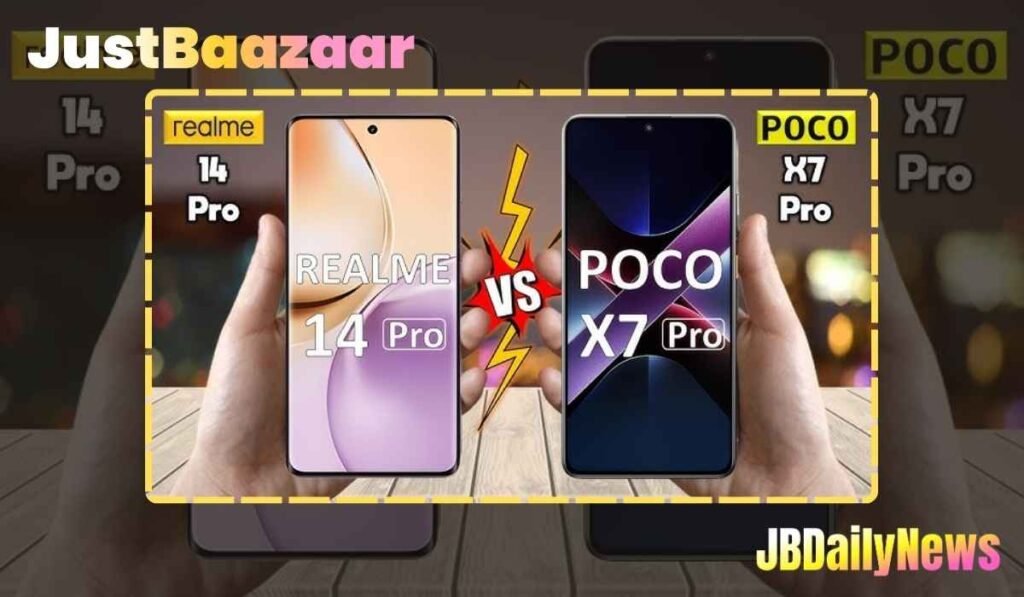In recent weeks, two highly anticipated mid-range smartphones were launched in India — the Realme 14 Pro and the Poco X7. Both phones are designed to offer high-end features at an affordable price, catering to the needs of budget-conscious consumers. While both of these smartphones come with competitive prices, they also have unique features that set them apart.

If you are looking for a smartphone under ₹25,000, the Realme 14 Pro and Poco X7 are two devices you should consider. Let’s compare them based on various aspects such as design, display, performance, battery, and camera, to help you make an informed decision.
1. Price in India
- Realme 14 Pro: Priced at ₹24,999 for the 8GB RAM and 128GB storage variant.
- Poco X7: Priced at ₹21,999 for the 8GB RAM and 128GB storage variant.
Both devices are within the ₹25,000 price range, offering competitive pricing for the features they bring. The Realme 14 Pro is slightly more expensive by ₹3,000, but it justifies this with its design, display, and performance features.
2. Design and Display
Realme 14 Pro Design
The Realme 14 Pro features a unique and modern design with a color-changing rear panel, making it stand out in a crowd. This color-shifting effect gives the phone a premium, futuristic look. Furthermore, the device is built for durability, with IP69, IP68, and IP69 ratings, making it resistant to water, dust, and extreme conditions.
Poco X7 Design
On the other hand, the Poco X7 features a more traditional design with a plastic back, giving it a more minimalistic and sleek appearance. It includes a square-shaped camera module and also offers IP66 + IP68 + IP69 ratings, ensuring durability similar to the Realme 14 Pro. While the Poco X7 is ₹4,000 cheaper, it still provides a solid, attractive build.
Display Comparison
- Realme 14 Pro: It comes with a 6.77-inch AMOLED display, offering vibrant colors and deep blacks. The 120Hz refresh rate ensures smooth scrolling and gameplay. With a peak brightness of up to 4500 nits, the display is easy to view under direct sunlight.
- Poco X7: The 6.67-inch 1.5K OLED display on the Poco X7 offers a sharp viewing experience, though it doesn’t reach the Realme 14 Pro’s level of brightness, peaking at 3000 nits. It also comes with a 120Hz refresh rate, making it excellent for fluid visuals.
Both smartphones boast impressive displays, but the Realme 14 Pro’s AMOLED screen with higher peak brightness might appeal to those who prioritize screen quality.
3. Performance and Battery
Performance
- Realme 14 Pro: Powered by the MediaTek Dimensity 7300 chipset, paired with 8GB of RAM and up to 256GB of storage, the Realme 14 Pro ensures excellent multitasking and smooth performance. The chipset is paired with a Mali-G615 GPU, enhancing the graphical performance, making it suitable for gaming and intensive apps.
- Poco X7: The Poco X7 comes with a slightly upgraded version of the same chipset, the MediaTek Dimensity 7300 Ultra, making it slightly faster and more durable for heavy tasks. Like the Realme 14 Pro, it features 8GB of RAM and 128GB of storage, with the same Mali-G615 GPU, delivering solid performance in gaming and multitasking.
Battery
- Realme 14 Pro: The Realme 14 Pro is backed by a 6000mAh battery, which should comfortably last through an entire day of usage. It supports 45W fast charging, ensuring the device can be charged quickly.
- Poco X7: The Poco X7 features a 5500mAh battery, slightly smaller than that of the Realme 14 Pro, but still capable of lasting through a full day. It also supports 45W fast charging, making it quick to recharge.
While both phones offer a solid battery life, the Realme 14 Pro’s larger 6000mAh battery gives it a slight edge in terms of longevity.
4. Camera
Realme 14 Pro Camera
The Realme 14 Pro focuses heavily on its camera setup, making it an appealing option for photography enthusiasts. It comes with a dual-camera setup, featuring:
- A 50MP OIS main camera with a Sony IMX882 sensor, ensuring stable and clear shots even in low-light conditions.
- A depth sensor that enhances portrait photography, providing a better bokeh effect.
For selfies, the 16MP front camera ensures crisp and clear shots, making it ideal for social media users.
Poco X7 Camera
The Poco X7 comes with a triple-camera setup, including:
- A 50MP main camera with a Sony LYT-600 sensor, offering good performance for general photography.
- An 8MP ultrawide camera to capture more in a single shot.
- A 2MP macro lens for close-up shots.
On the front, the Poco X7 offers a 20MP camera for selfies, which is higher than the Realme 14 Pro’s 16MP camera.
In terms of raw camera power, the Realme 14 Pro’s main camera might offer more stability and better performance, thanks to the OIS (Optical Image Stabilization). However, the Poco X7 offers more versatility with its ultrawide and macro lenses.
Conclusion: Realme 14 Pro vs Poco X7
Both the Realme 14 Pro and Poco X7 come packed with impressive features that make them great contenders in the under ₹25,000 segment. Here’s a quick breakdown of their strengths:
- Realme 14 Pro: A slightly higher price but offers a larger AMOLED display, superior battery life, and a more stable camera setup with OIS.
- Poco X7: A more affordable option with a triple-camera setup, solid performance, and an impressive selfie camera.
If you’re willing to spend a little extra, the Realme 14 Pro is the better option for those who prioritize a high-quality display, longer battery life, and stable camera performance. On the other hand, if you are looking for a more budget-friendly option, the Poco X7 will provide excellent value for your money, especially with its triple-camera setup and high-resolution selfie camera.
Both smartphones cater to different types of users, so it ultimately depends on your preferences. Consider what matters most to you—be it the design, display, battery life, or camera—and choose accordingly.














